The differences between hybrid and heirloom wheat strains compared to genetically modified, or GMO wheat approved by the FDA. Which are safe to eat and what to avoid!

The bestselling book Wheat Belly, by William Davis MD, resulted in many people believing that genetically modified (GMO) wheat is already present in the food supply.
While it is true that scientists around the world are testing GMO wheat including the United States, a drought-tolerant variety is only being cultivated in South America at this time. (1-4)
The warnings against wheat in Wheat Belly are specifically in reference to hybrid wheat strains. This is very different from genetic modification.
However, GMO wheat is definitely on the horizon in the United States and coming at us very quickly with the recent FDA approval of Argentina’s drought-resistant strain. (5, 9)
Let’s examine the differences between hybridized and GMO wheat and what to know to eat wheat safely in the changing landscape ahead.
Hybrid Wheat
Most of the wheat in the world is hybridized.
The only non-hybrid exception is einkorn wheat, which is in the same natural state it was many millennia ago. It is, in fact, the first and most ancient cereal grain known to humanity.
Contrary to popular belief, all other heirloom or “heritage” wheat varieties are hybridized.
Familiar examples include spelt, kamut, red fife, and white sonora, among many others.
Be aware that food propaganda from mainstream media has intentionally conflated the terms “GMO” and “hybrid”. (6)
Thus, it is critically important to understand the scientific distinctions between the two.
Hybrid Plant Cultivation
When hybridizing a plant, farmers select for one or more natural DNA characteristics during cultivation.
This encourages the development of a strain that is, for example, sweeter, larger, or more resistant to drought.
Hybridization never involves tampering with DNA by mixing it with an unrelated species.
Thus, hybridization can occur either spontaneously in nature or via careful cultivation by farmers.
Genetic Modification
By comparison, genetic modification mixes the DNA of different species.
One of the earliest attempts at GMO wheat was the creation of triticale, a forced and unnatural cross of wheat and rye. Triticale seeds are sterile.
Since then, DNA mixing has gone even further off the deep end, involving the mixing of plant, animal, insect, or even microbial DNA!
In short, genetic modification is a completely unnatural, “Frankenfood” approach to cultivation.
In my opinion, it is an abomination.
Beyond the moral issues of risking planetary health through the introduction of unnatural, invasive species, there are significant health risks to humans who consume GMO foods.
Genetically modified foods trigger a massive inflammatory effect in the body. They should be avoided at all costs.
Hybrid vs GMO Wheat
Applying these differences to a practical level, hybridization of plants has been practiced for centuries by farmers.
In fact, most of the plant foods we consume every day are hybridized in some form or fashion.
As mentioned earlier, hybridization occurs through the selection of desirable and inheritable characteristics that are either dominant or recessive genetic traits.
It can also happen spontaneously in nature due to environmental stress of some kind.
In the case of wheat, strains that are high in gluten have been favored in recent decades given that they are more desirable in food processing.
High-gluten hybrid wheat holds together better for massive food production and shipping purposes.
The result is that modern wheat is much higher in gluten than nonhybridized strains (einkorn) or even hybridized heirloom varieties such as spelt.
How did modern wheat get so high in gluten?
The reason is because modern wheat was artificially hybridized using radiation during the “Green Revolution” of the 1950s and 1960s.
This suspect process produced hybrid strains in a lab that perhaps would not have been possible using traditional cultivation practices. (7, 8)
Is Hybrid Wheat Healthy?
So far, we’ve established that GMO wheat is not the same as hybrid varieties.
GMO wheat is not safe to eat. If and when it makes its debut into the food supply, avoid it like the plague!
What about hybrid wheat? Can this be consumed safely?
My opinion is that heirloom wheat varieties that are natural hybrids using ancient cultivation techniques would be safe to eat.
This is assuming that your digestive system is in good shape and you can eat it without any autoimmune or inflammatory symptoms.
Sourcing Wheat Varieties Safely
Modern wheat is another issue entirely. This type of hybridized wheat was created using radiation-induced mutagenesis.
Irradiated wheat is the type of wheat in processed foods and the form most people have issues with.
Although I can digest modern wheat without symptoms, I choose to avoid it in favor of heirloom varieties or (best choice), einkorn (here’s the source I suggest).
These varieties are more nutritious and put less of a strain on the digestive system.
If you choose to eat modern wheat because it is less expensive, I would suggest, at the very least, to always buy organic.
This is because modern wheat crops are desiccated with herbicides containing glyphosate right before harvest.
This virtually guarantees a heavy residue in the wheat flour ground from these kernels.
Glyphosate (Roundup) destroys gut flora. In addition, it contributes in a massive way to the development of autoimmune issues including cancer.
Another tip. Whatever form of wheat you eat, sprouting, soaking or sour leavening grains as practiced by traditional societies is still a critical step. This careful preparation breaks down gluten into more digestible form and allows better nutrient assimilation with less strain on digestion.

(1) The World’s First Drought Resistant GMO Wheat is Here
(2) GM Wheat that Repels Aphids Grown by British Scientists
(3) Brazil approves GMO wheat on food supply fears
(4) GMO Wheat Being Tested in Two States
(5) GMO wheat gets OK from U.S. FDA
(6) Farmers may have been accidentally making GMOs for millennia
(7) Wheat mutagenesis by combining recurrent irradiation, hybridization and DH-technology
(8) History and Overview of the Green Revolution
(9) GMO wheat in the US? It’s getting closer








I appreciate your choice of word to describe the gmo wheat as “abomination“! I would agree and so does the Bible. We are told to not mix seeds and people have not understood that plants are not the only thing that is described in the Bible as having seed.(think of man and animals having seed). To mix different “kinds” is sin and will have consequences. (Like kind after like kind)
I read that it’s not even wheat that is the issue, it is how the wheat is processed into flour that is the problem? chemicals, bleaching, treatments, etc?
Yes, that is why it is a very good practice to always grind flour fresh yourself. So easy to do and fast too. https://www.thehealthyhomeeconomist.com/video-grain-grinding-101/
I do agree that we need to fix the gut in all cases…but this been said,i doubt that we wheat one can fix the gut! Carbohydrates never were and never be an essential food for the human body! Healthy fats, protein and fiber will do all that fixing part of the gut and reintroducing wheat in the diet will just add more work for one to keep the gut in a good balance! Carbohydrates are maybe needed in a very small amount but certainly not from wheat.There are many other better sources! I had huge problems in the past from wheat and i would not give it a second chance to destroy my gut again!
Has anyone considered that it’s not the wheat that is the issue and perhaps delve more into the process of how it is the industrial process where the assimilatable ingredients are stripped. So the flour has a longer shelf life but void of the micronutrient density that pound for pound make it the healthiest food out there. People seem to miss that. Mill your own flour and see the difference with the store bought flour. Night and day.
You are wrong- the literal definition of hybrid is an offspring derived from two different species. To achieve this, the combination of genetic information is required and that modifies the DNA. You can’t combine two sets of DNA but still have the exact same DNA.
I’m sorry but your sooo wrong. Wheat does not naturally form hybrids as other plants do. It is naturally self pollinating and hybrid wheat is only the result of wheat being FIRST sprayed with chemicals to partially sterileze it, then being mechanically pollinated! Those chemicals ruin peoples endocrine systems, no matter how much you ferment, sour, sprout or anything else. EVEN ORGANIC WHEAT IS HYBRIDIZED! And as such contains STERILIZING CHEMICALS!
I have been a Weston Price fan for over a decade and always soured-completely!-my own wheat. I have had to be off wheat for long periods of time. trying to figure out what I did wrong. after MANY YEARS of experimenting discovered the issue with hybridized wheat. The chemicals they use ruin the wheats ability to self pollinate by inhibiting its own chemical production. I have severe symptoms of adrenal failure and diabetes after only a few days of soured/fermented, organic non-gmo wheat. I am more sensitive than most due to my childhood of poor health. I know for a FACT that it is impossible to naturally hybridize wheat. The chemicals from hybridized wheat inhibit pituitary and adrenal function and thus can be responsible for DIABETES, HEART DISEASE, CANCER, LIVER FAILURE, CANDIDA and more. Anything that changes the way the body releases or uses chemicals can be deadly. I know plenty of people with hashimotos that goes away when they don’t eat wheat also-FERMENTED OR NOT!
The braindead farmers are killing us by their selfishness and greed! Even the organic ones! Don’t be a part of the idiocy!
I suggest reading the book on Einkorn by Carla Bartolucci for clarification about the history of wheat. She was a recent speaker at the WAPF Conference too.
I have been dealing with Ulcerative Colitis for the past 10 to 12 years. Two years ago the Doctor told me I had Pandemic Ulcerative Colitis and dysplasia had developed. I was told I was now at the highest risk point for Colon Cancer. Every joint in my body ached and I had to find out what was going on. I stopped eating most foods that contained gluten and began to feel better, much better. I changed my diet and received the best news last month when my Doctor notified me that there was no evidence of active or inactive colitis and no dysplasia. I don’t know what else to say. I cut out wheat products and most gluten, not all gluten but bread and snacks with wheat and purchased pasta from Italy. Small changes that produced great positive results for me. So now I have cut out all wheat products to see if I feel any better. I don’t think I’ll stop forever, but seems too much altered wheat is in every food item sold and one has to start to identify for themselves what foods are causing problems in their life. Good luck to those who are searching for information on healing and I hope each of you who are suffering like I was gets the good news I got.